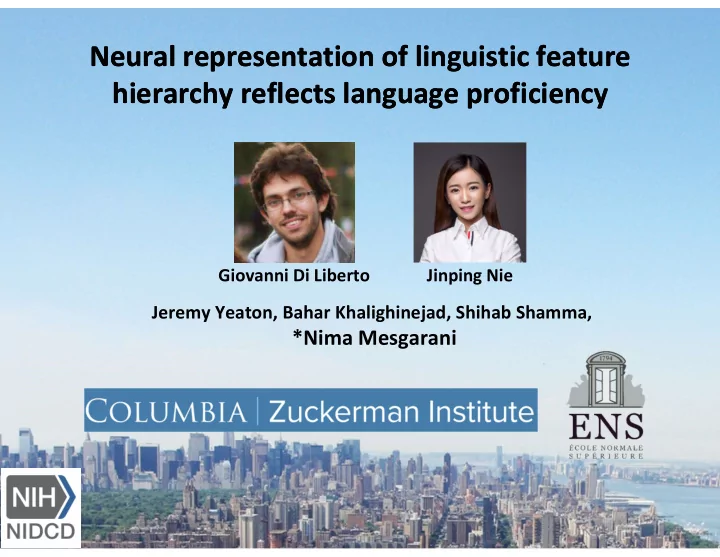

Neural representation of linguistic feature Neural representation of linguistic feature hierarchy reflects language proficiency hierarchy reflects language proficiency Giovanni Di Liberto Jinping Nie Jeremy Yeaton, Bahar Khalighinejad, Shihab Shamma, *Nima Mesgarani
Speech processing hierarchy • Learning a new language requires learning new sounds ( phonemes ), new sound combinations ( phonotactics ), and new words ( semantic ) • Language acquisition is cumulative; proficiency can be quantified (e.g., Basic, Independent, Proficient) • How does language proficiency change the neural representation of linguistic feature hierarchy?
Native (L1) and non-native (L2) English speaking subjects Language proficiency: Number of subjects: 17 16 16 22 71 total • L1: 22 Native English speakers • L2: 49 Native Mandarin speaker with instructed English acquisition • No significant difference between age and time in the US
Experimental procedure 1.5 hours continuous speech stories, divided into 24 blocks, alternating male and female speakers (4 speakers total) Similar task engagement
600 ms Regression weights (a.k.a TRF) show the contribution of each feature to the response Lalor ‘ 2009, Di Liberto ‘ 2016,2019, Broderick ‘ 2018, Brodbeck ‘ 2018
Hypotheses With increased language proficiency in L2 subjects, the neural representation of: 1. Low-level acoustic attributes will not change 2. English phonemes will be more similar to L1 (learned phonetics ) 3. Phonotactics will approach L1, but not entirely to preserve L2 phonotactics (learned phonotactics ) 4. Semantic dissimilarity becomes more pronounced (learned words )
Envelope TRF • Reflects the processing of basic acoustic features • No significant change with proficiency
Phoneme TRF Proficiency shifts the neural representation of phonemes toward L1
Increased phoneme similarity to L1 is higher for English-only phonemic contrasts
Learning new phoneme sequences: phonotactic TRFs • Early negative in all L2 subjects, but not in L1 (~240 ms) • Late Negative for L1 & C (~360ms), and even later for A & B (~ 480 ms)
Semantic dissimilarity TRF • Early negative in L1 subjects (~240 ms), Later in C (~360 ms) • Weaker in A & B
Predicting language proficiency from TRFs Language proficiency is highly predictable from EEG High classification accuracy for L1 vs. L2 , but also L1 vs. C
Proficiency changes the encoding of linguistic hierarchy in EEG responses to continous speech phonemes phonotactics semantic • Objective measure of proficiency & nativeness • Age of acquisition, frequency of exposure, etc.
Recommend
More recommend